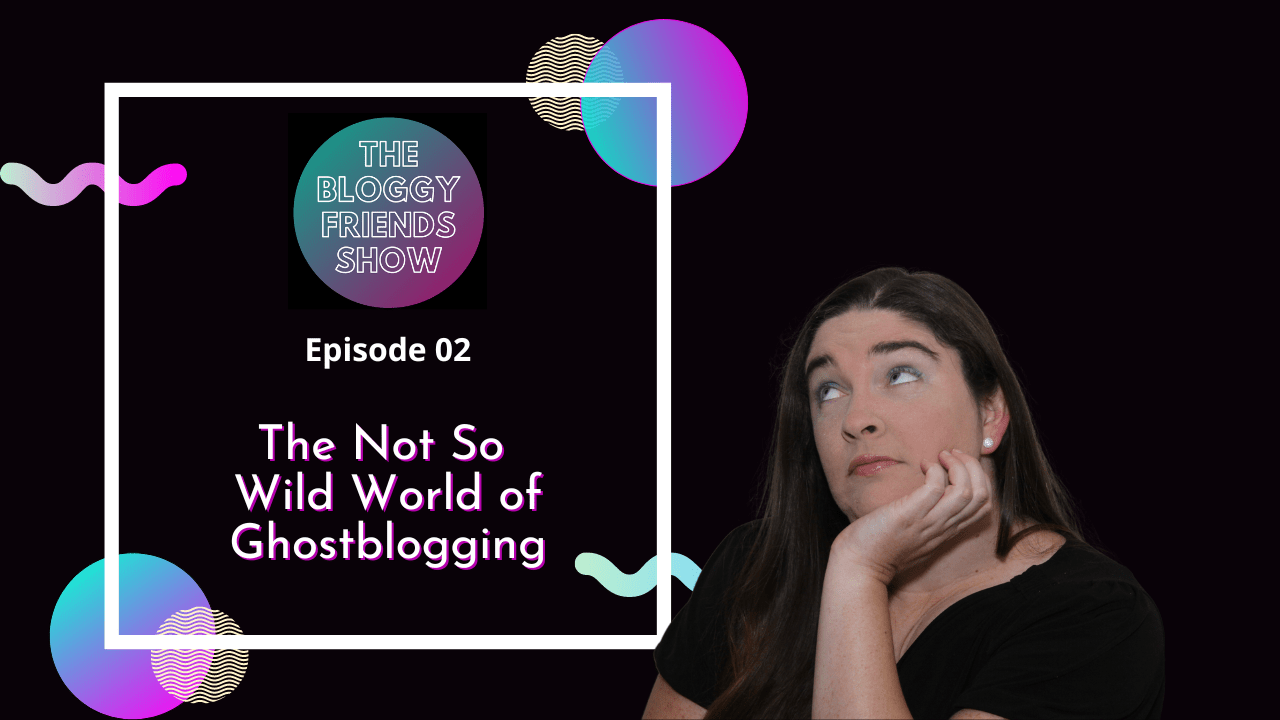Welcome to Episode 2 of the Bloggy Friends Show where we chat about The Not So Wild World Of Ghostblogging.
Episode 2 of the Bloggy Friends Show Notes
In this episode of the Bloggy Friends Show titled “Ghostblogging,” Famous Ashley Grant discusses her experience and insights into the world of ghostblogging. She shares how she got started, the challenges she faced, and the opportunities it presented. Ashley emphasizes the importance of being a good writer and learning the client’s voice. She also talks about the benefits of ghostblogging, including the ability to work from anywhere in the world. Ashley offers advice on breaking into the industry and highlights the significance of having writing samples, or clips, to showcase your skills. Overall, this episode provides valuable information for those interested in pursuing a career in ghostblogging.
Tune in on YouTube instead:
How to Become a GhostBlogger
What’s up, everyone? Famous Ashley Grant here, and welcome to the ghostblogging episode of the Bloggy Friends Show. Before I dive into today’s content, I just want to thank everyone for their reactions to my first episode. I was so scared to release this podcast. For years I’ve wanted to do an online show you guys, and every time I started to write an outline or record audio, I would just tuck it away and push it to the side. It’s why I released the first episode on April Fool’s Day, honestly. I want to release weekly episodes on Fridays, but I chose a Wednesday for the inaugural episode just so it could fall on April Fool’s.
I figured if it sucked I could just say it was a joke. Ha!
But so far, everyone has been so supportive. You all have been so awesome with your messages, comments, and words of wisdom. I know I’ll probably keep being scared for a while. But, I’m going to keep trying and powering through the fear because I have big plans for this show and future projects, and my goals aren’t going to accomplish themselves. Anyway, I just wanted to share how much I appreciate the feedback, and let you know that I’m going to keep going and keep chasing my dreams. I’m grateful to have such amazing people in my corner rooting me on.
Alright! Enough of this sappy show of emotion. Let’s get into today’s content. Shall we? I want to talk about ghostblogging. Ya know? This episode is going to serve a little bit as a time capsule in a way because right now in 2020 we’re living through a pandemic. Something that was never even on my radar.
Because of miss coronavirus, so many people are losing jobs or having to transition their 9 to 5 jobs into stay at home work. Many entrepreneurs I know are still working, but even they have taken pay cuts and had struggles as a result of these insane times. I’m incredibly grateful that I’ve worked from home for more than a decade. Sure, I’ve had a few 9 to 5 stints here and there, but for the most part, I’ve been a work from home writer.
As the workforce has been changing, I’ve gotten questions from people about how I’m still earning a living, and how they can do it too. So that’s what I want to talk about today. The not so wild world of ghostblogging.
What is a ghostblogger? Odds are you know what a ghost writer is, but just in case you don’t — a ghost writer is a writer who pens content on behalf of another individual, in their voice (or as close to it as possible when you don’t share a bloodline, and might never even have met in person) and with their byline. Ghost blogging is very much the same thing, only instead of writing books, pamphlets or press releases, you write blog posts on behalf of someone else (i.e. the person who pays you and strokes your fragile self-confidence by telling you how amazing you are).
I focus strictly on blog posts. Both short and long form, but blog posts only nonetheless. Why did I choose ghost blogging?
As I mentioned in the last episode, I got into ghostblogging in January 2014 when it literally landed in my lap. A lady I had met asked me if I would be interested in writing her blog posts because her writer was quitting, and she didn’t have time to produce her own content. Because I was losing work at the time, I jumped at the chance.
That first year was a whirlwind of chaos and learning curves. I had to learn the client’s voice, and then as I gained new clients, I had to learn their voices too. It ended up being an amazing year though, and I earned enough to go on my first vacation in years. We went to Thailand, and while we were there I realized that I could turn this into an amazing business working from anywhere in the world. Though my name wasn’t on the blog posts, I was making good money, and I knew I could keep working on my own blog in my free time.
I’ve ghostwritten books and press releases and landing pages too. But blogging always ended up being my favorite type of content. That’s why I started turning down offers for other work, and focused mainly on ghostblogging.
Since that first year, I’ve gotten a lot of questions about how to get into ghostwriting. I thought this would be the perfect time to lift the curtain and tell you everything I know about breaking into the world of ghostblogging.
For starters, you need to be able to write a blog post. There are plenty of places to learn copywriting, and with practice you can fine tune your process of researching and writing both short form and long form pieces.
You have to be a decent writer. You wouldn’t go to a hairstylist who gets lots of complaints online that they don’t know how to style hair, would you? Wait a minute – Am I the only one getting flashbacks to the movie Grease when Frenchy accidentally mismatched the colors and turned her hair pink in beauty school?
I can suddenly hear Frankie Avalon singing Beauty School Dropout…
Just me? OK … moving on!
Back to the importance of being a decent writer; notice I didn’t say the greatest writer who ever lived (that’s why we have editors). Imagine you and another person are being chased by a bear — you don’t have to be faster than the bear, you have to be faster than the other person who is also being chased by the bear. It’s the same with writing. All you really need is to be better at writing than the person you’re writing for!
The number one question I get from people thinking about becoming a ghostwriter is “Do I need a website?”
To this I say, no. Not exactly. But what you do need, is clips. You need some kind of proof that you can write.
Interestingly enough, when I start ghostblogging, I did not have a “traditional” or “typical” writer’s website. Sure, I had clips of pieces written, but not an actual website.
In fact, my first ghostblogging client found me because she saw stuff I had written in the newspaper and in local magazines.
But, how can YOU break into ghostblogging? In other words, How can you prove you know how to write without a website?
- Write on Medium.com
- Write on other people’s blogs. This is called guest posting and I plan on doing an entire show about that in the future
- Write on your own blog
- You could even write mock posts on Google docs that you can share with potential clients. The main key is to write something on a platform that gives you a link that you can send to someone who asks for clips.
I get it! Building a writer website can be time-consuming, and most people looking to break into ghostblogging want to start working right away. Building a website can take significantly longer than you might have time for. So, if I was starting over again today, and couldn’t build a website…here’s what I would do….
Create a Facebook fan page and call it something simple like Ashley’s Ghostblogging Business – these are FREE!
Write a post, or a few posts on Medium.com about the type of content you want to be hired for.Yep, I’m talking niches people. The cool thing about blogs is there are LOADS of topics…so you can set yourself apart by becoming an expert in one topic and get lots of work in this area.
When I first started ghostblogging, I was writing almost exclusively for travel agencies. I got really good at knocking out posts quickly because of how many assignments I had in the travel niche. And, the best part? I started learning how to come up with blog post ideas because I had written so much about travel in a short period of time. In one year alone I wrote more than 100 posts on travel. It’s crazy when I think about how much I have grown since then.
Start thinking about what topics interest you. Odds are there are businesses related to your topics. For example, if you love jewelry, perhaps you could work on blogs for business owners that run Etsy businesses or homemade jewelry. If you’re all about fitness, perhaps you could write for a personal trainer or even a gym franchise. Maybe you could talk until you’re blue in the face about homeschooling – there are virtual business owners that need writers to post about that too!
If you can’t find businesses that are related to your topic exactly, are there ones out there that interest you just enough? Probably! The possibilities are virtually endless.
But let’s get back to my “what I would do if I was starting today” scenario…
Once I had a Facebook page up, and a few posts about the topic I want to write about published on Medium.com – I would then:
– create a Paypal account if I didn’t already have one
– create a contract for clients
– decide on your pricing strategy
– get on Canva.com and develop some graphics announcing that I’m a writer for hire
After the business side of things was handled, I would start going about finding my first clients.
You need clients if you’re gonna make any money, am I right?
Where are these potential clients, you ask? Everywhere, my bloggy friend! They are online, offline, and they might even live next door. In fact, they might not even have a blog yet.
Odds are you already know someone (or you know someone who knows someone) who needs a writer. To start, I would go to my current network of friends and family. I would share my clips and ask them if they know anyone who would need a writer for content like this.
If I didn’t get any bites, I would start searching for businesses I’d like to work with. I’d grab my local chamber of commerce directory, join networking in person and online, join Facebook and LinkedIn Groups and basically tell everyone and their brother I’m open for business. All the while, I’d continue writing on Medium and other platforms about the topic I want to ghost blog about. I’d share the posts on Facebook, Twitter and LinkedIn with a simple message that said something like “I you need content like this, DM me”
Now, I’m going to let you guys in on a little secret I don’t think I’ve shared anywhere else. When I’m in a pinch for client work, and leads are drying up, I go to PR and Marketing Agencies. Here’s the thing – all of their clients need content and they know it. They can have in-house staff do most of it, but sometimes they will bring on outside contractors to knock out the work that much faster. That’s where people like me come in. This allows them to get the job done, look good to the client, and I get paid. Everybody wins.
Most of the work I have gotten has been via referral, but when I really need work, I often will go back to the list of agencies I haven’t pitched yet and throw my hat in the ring. More often than not I get a message back that they don’t need anyone right now, but that they will keep my information on file because they like to have a pool of writers. Follow up when you need more work, and reach out to new places as often as you can. You never know when a pitch will yield work – it could be immediately, or it could be far down the road. That’s why you have to continue pitching yourself.
I will tell you I also have gotten work on sites like Upwork and Fiverr. Now, listen. I know these websites get a bad rep, and yes, there are a lot of jerks on there looking for cheap labor. BUT! You can actually secure work on these platforms, you just have to be careful. Still, I agree that these platforms are more of a last resort than where you should begin your hunt for clients.
Other places I have found writing gigs have been on job boards, by attending conferences, and even by being a guest on radio, television, and other podcasts. In fact, one podcast I was a guest on yielded more than $400 in a single day. I got to promote my business, and landed an easy $400 while providing content to the podcast host. It was a wonderful experience, and I have since been on other podcasts getting my name out there. Again, you never know where your next gig will come from, so you have to keep marketing and promoting yourself.
One place some of my writing friends have found success in landing gigs is Facebook Marketplace and in Facebook groups where you can “sell your content.”
If you’re like me and hate putting on anything but yoga pants, you’ll likely want to look for most of your clients online. Believe it or not, I’ve never met 90% of the people I’ve worked for. We literally handle all of the elements of our business online. It’s awesome!
I love ghost blogging as a business because I get to make my own hours, and work at my own pace. I negotiate my rates, and then do the work and get paid. It’s truly been the most fruitful work of my writing career.
Let’s talk about what to do once you land your first client. You’ll first negotiate and agree on the terms of your writing gig. Save your emails and get everything in writing. If they want to chat on the phone or via Skype, that’s fine, but do yourself a favor and send them a recap email of everything that was said and get confirmation so you can ensure you are on the same page. You may want to get a contract in place as well to protect both you and the client.
Before you write a single word for them, agree to details like the date of delivery, whether or not your fee includes a re-write, whether the tone will be friendly or professional, the keywords they want included in the post, approved places for research…and so on.
You also need to agree on the method of payment, and how invoicing and payments will be handled. Some writers I know charge non-refundable deposits up front, and others charge the full amount once the job is done. You have to decide what works best for you.
After everything has been agreed to, it’s time to get to work. Here’s my suggested workflow for writing assignments:
Step 1 –
Get the topic the client wants along with the keywords they would like you to include in the post. If they have any research they have already done on the topic, go ahead and get that from them as well.
Step 2 –
Remember, only AFTER agreeing to terms, topics, word length, etc… should you start writing. Now it’s time to start researching your topics
Want to understand jet lag so you can ghost blog for travel specialists? Fly to Thailand, like my husband and I did earlier this year. It’ll make you a better blogger.
If you’re writing for a photographer, you’ll need to research their photography style and website and the photography topics they want to cover in their blog posts extensively so you can write with authority. With their byline on the post, their reputation is on the line. I suggest going after clients who need the type of content you already know about. It will make your life much easier.
When I started writing for travel agents I had to do a ton of research that might not have taken so much of my time if I’d initially known more about the travel industry than how to book a ticket online. After years of working with and ghostwriting for travel agents, I’m still learning and doing quite a bit of research — but at least I have a better grip on the subject. My industry-specific know-how now helps me assist in coming up with post ideas and knowing where to go to even begin the research process.
Step 3 –
Write the post by the date you said you would and send it to the client either as a Word document, a Google doc or in the body of an email (how you submit your work will depend on what you and the client agreed to ahead of time) i personally prefer Google Docs because I can access them anywhere with WiFi and both I and the client can add comments directly into the document for edits and ideas
I have to take a quick moment here and reiterate something of great importance. Always meet your deadlines! Trust me, the fastest way to lose your blogging clients is to be late and/or drop the ball completely. If they want a post every Friday by 5 p.m., you better make sure they get their posts every Friday by 5 p.m.! Bonus points if you’re early because then they really know they can rely on you.
Here’s the thing, in the past 13 years I’ve written a lot of content. I’ve also been an editor and a manager and someone who hires and fires writers. Nothing irks me more than a writer who can’t meet a deadline. Especially if they don’t communicate with me that they will be late with a good reason. I personally have blacklisted writers who can’t communicate, follow instructions, or meet deadlines. I don’t want that to happen to you. So, just please, communicate with your clients and be on time. Okay, end rant.. Back to my suggested steps for your workflow
Step 4 –
Rewrite the piece if necessary. This may be needed a lot in the beginning as you learn your client’s voice.
Remember, the whole point of ghostwriting is to allow your client to take the credit. If they would never use certain quotes or say certain things — like “dude” or “awesome” or “put a pin in it” — you’ll need to adapt to their way of writing. For example, one of my clients hates the phrase “not so much” and another doesn’t like any references to tofu in her healthy eating blog posts.
In the beginning, you need to interview your client thoroughly to learn how they talk and what they want to get out there to their readers. Both your credibility and your profit margin shrink every time you have to revise a draft because the voice is off.
Step 5 –
Invoice the client for the work provided.
Add terms and conditions for when you want to be paid. Set this precedent in the beginning so there are no surprises. For example, every invoice I send out states TERMS: NET 30 days, and past due amounts are subject to a $10 or 10% late fee whichever is larger. Because I’m clear on this, there isn’t a surprise when a late fee invoice is submitted.
Now for the hardest part about being a ghostblogger… well, at least it is for me.
You have to keep your work a secret.
If you can’t handle keeping mum about what you’ve written, ghost blogging might not be a good option for you. I sometimes have trouble with this myself because I’m one of those vain writers who can’t wait to tell everyone about my latest work (surprising, I know), but unless your client is OK with going public about using a ghost blogger, you better keep your mouth shut. In fact, don’t be surprised if you have to sign a nondisclosure agreement, which means you could face legal ramifications if you don’t keep quiet about your work!
The truth is ghost blogging requires a lot of work, but when you’re willing to put in the effort you can develop a pretty decent stream of income before you know it. So, the question now is what are you waiting for? Get your clips together and start looking for work today!
That’s all I have for today’s episode. I hope this was inspiring and gave you a glimpse into being a ghostwriter. Thanks for listening, and Until next time, may your page views be high, and your bounce rate be low.
Subscribe to the Bloggy Friends Show – Google Podcasts | Apple Podcasts | Spotify | Amazon Music






